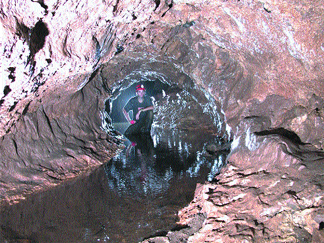 As depicted
in the recent movie The Day After Tomorrow, changing the amount of freshwater
entering the North Atlantic Ocean can have serious climatic implications around
the world (although perhaps not so quickly). That was the case 8,200 years ago,
when areas of the Northern Hemisphere became anomalously cold and dry, according
to geologic evidence from Greenland ice cores and elsewhere. And new data from
a stalagmite in the tropics suggest that the climate changes reached even farther,
which could have implications for the global connections of climate change.
As depicted
in the recent movie The Day After Tomorrow, changing the amount of freshwater
entering the North Atlantic Ocean can have serious climatic implications around
the world (although perhaps not so quickly). That was the case 8,200 years ago,
when areas of the Northern Hemisphere became anomalously cold and dry, according
to geologic evidence from Greenland ice cores and elsewhere. And new data from
a stalagmite in the tropics suggest that the climate changes reached even farther,
which could have implications for the global connections of climate change.Clues from inside caves in Costa Rica and Panama are helping Matthew Lachniet, pictured here, and colleagues develop temperature and rainfall records for the last 20,000 years. Courtesy of Keith Christenson.
When the last ice age was ending, glaciers retreated and left large lakes in their wake. The lakes then rapidly drained into the North Atlantic, cooling sea-surface temperatures and disrupting the circulation of warm, salty waters from the tropics to higher latitudes.
Suspecting that high-latitude temperature changes may have affected the climate in the tropics, Matthew Lachniet, a geologist at the University of Nevada, Las Vegas, and colleagues went looking for clues in a 35-centimeter-tall stalagmite from an inland cave about 10 meters belowground in Costa Rica. The team had been developing temperature and rainfall records of the past 20,000 to 30,000 years in Costa Rica and Panama.
Determining the age of the stalagmite using uranium-thorium dating, and then dissecting it into almost 300 pieces for oxygen isotope sampling, they found a marked 200- to 300-year dry period, as published in the November Geology. From roughly 8,300 to 8,000 years ago, "rainfall was much weaker," Lachniet says. "And it just happens to directly correspond to the anomalous cold periods in Europe and elsewhere." The cold-dry anomaly, he says, is unprecedented at other times in the Holocene, but is likely to be found in other records of post-glacial periods throughout history.
"This is a nice record and important new data," says Larry Peterson, a paleoclimatologist at the University of Miami in Florida. "I'm not surprised that this cold event showed up in the record in Costa Rica. The clear evidence for dry conditions is consistent with what we've found and would predict" from similar indications of the 8,200 event in the Cariaco basin off the coast of Venezuela. With each new paleoclimate record that is found, Peterson says, it is interesting to see similar spatial patterns of change emerge during cold periods of different duration. And it is becoming clearer that cold-dry events at high latitudes directly correlate to cool-dry periods in the tropics.
Understanding these connections may have implications for models of future climate change as well. For example, Lachniet and colleagues write, if high-latitude glaciers were to melt due to global warming and unleash a large volume of cold freshwater into the oceans, global climate could be vastly affected.
In Central America, that change could mean a weaker monsoon, Lachniet says. For communities that rely on monsoon rainfall for agriculture, drinking water and even freshwater for the operation of the Panama Canal, there could be serious socioeconomic impacts.
A small change in the monsoon could mean big changes for societies around the world, Peterson agrees. "The tropics have been undersampled and we need to develop more paleoclimate records from archives such as stalagmites and corals, which have the potential to produce beautiful climate records."

